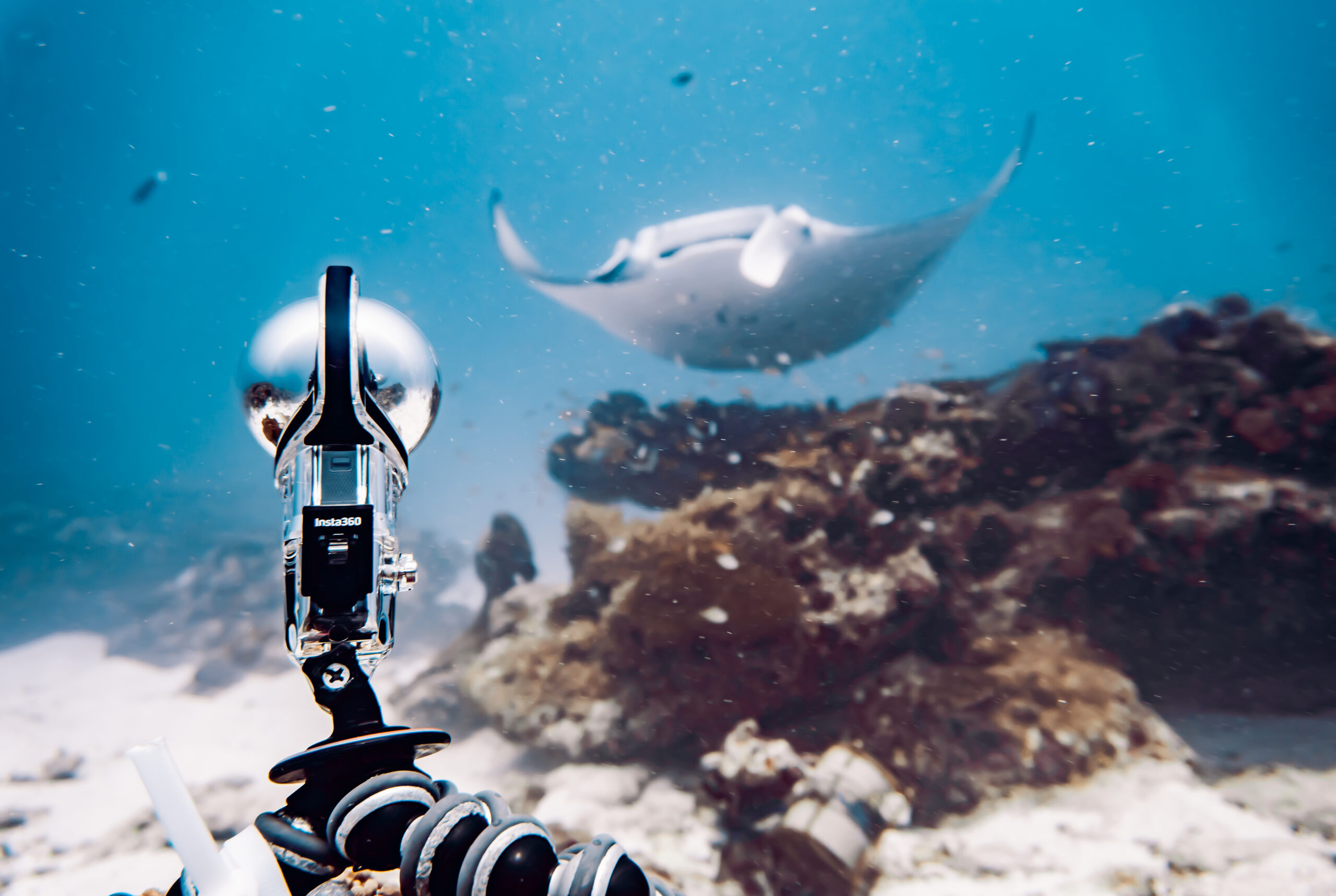Discovering the underwater symphony of cleaning stations
In the beautiful waters of Laamu Atoll in the Maldives, an exciting new collaboration between the Manta Trust team and the University of Bristol is starting to listen to the sounds of manta ray cleaning stations! Yes, you heard correctly – we are listening to cleaning stations – but I will get to that! You might be aware that manta rays and many other marine animals visit cleaning stations to get cleaned by the often hundreds of small cleaner fish which feed on parasites and leftover food which got stuck in the manta’s gills! Manta rays often spend hours on these small biodiversity hubs, not only to get cleaned but also to socialise with other manta rays and to warm up from deep dives in colder waters. And now you might wonder, how or why we listen to these cleaning stations – let us explain.

Mantas under surveillance. Researchers not only watch what mantas are up to when humans aren’t around, they now listen to them too! Photo © Miriam Staiger
Our new project with the University of Bristol started when Professor Steve Simpson visited Six Senses Laamu and the Maldives Underwater Initiative (MUI) in March 2023. Inspired by the incredible research that Steve had been conducting on discovering the acoustic worlds of marine life, and even being featured in BBC Blue Planet II, the Manta Trust team envisioned probing the soundscapes of cleaning stations. What would it be like to be diving into the acoustic cues that manta rays or cleaner fish might utilise during these intimate interactions? Do cleaning stations have a unique sound? Do fish communicate if encountering human-induced noise and how does this affect the intricate symbioses on a cleaning station? Well, we are eager to find out!
Discussions between the Manta Trust and Steve Simpson’s research group, to study acoustic cues utilised by manta rays, had already started some years ago, but this time we had the perfect set-up to get started. This was when the “Ears on the Reef” project was born, complementing our longstanding “Eyes on the Reef” initiative, where we deploy remote underwater cameras to observe manta ray behaviour when humans aren’t around.
“This research opens up a whole new world to us,” says Manta Trust’s project manager Miriam Staiger – as we dive into the rarely acknowledged world of underwater soundscapes, we are trying to understand and interpret the language of marine creatures visiting Laamu’s cleaning stations, like no one has ever done before. This is such a crucial step in understanding the often-overlooked auditory dimensions of our oceans, focusing specifically on manta ray cleaning stations and aggregation sites. Since May 2023, the Manta Trust team has been collecting a huge library of underwater acoustic recordings from various cleaning stations. Prof. Steve Simpson supplied us with a set of HydroMoths, compact acoustic listening devices that can be deployed on the stations attached to dive weights, so we can capture the diverse sounds and communications of marine life – day and night! To match the acoustic cues with visual data, we continue to deploy remote cameras, such as the Insta360 camera and various GoPros. This synchronised approach enables the correlation of acoustic recordings with visual data, providing insights into the language of individual fish – and believe us when we tell you – cleaning stations are noisy places – full of crackling, buzzing and grunting fish communication, it’s such a joy to listen to the recordings.

An acoustic listening device, a so called HydroMoth, and an Insta360 Camera – the equipment used to discover cleaning station soundscapes in Laamu Atoll. Photo © Miriam Staiger
With two new Master of Research Students from Steve’s research group in Bristol, the team are now analysing the acoustic soundscapes of cleaning stations in Laamu Atoll, building a comprehensive understanding of the interplay between manta rays and their surroundings. The objective is to create a spatial sound map of cleaning stations around the atoll, correlating underwater melodies and noise pollution with manta ray presence, abundance, and behaviour.
While Laamu Atoll is currently still a remote destination with minimal shipping traffic, the threats of industrial expansion and unsustainable tourism are growing, more akin to many other atolls in the Maldives. Our “Ears on the Reef” project will not only better understand the marine life utilising cleaning stations, but also arm conservationists with knowledge to develop best practices for boating and diving to minimise impacts of noise pollution stress on animals.
The team is incredibly grateful for the collaborative spirit of the University of Bristol, the support of Six Senses Laamu, the dedicated MUI team and all supporters of the Manta Trust who make this work possible. Stay tuned and keep your ears open for further updates on this acoustic journey into the depths of Laamu Atoll’s underwater symphony!
